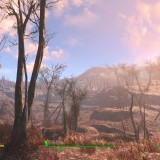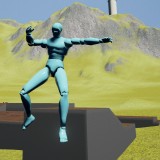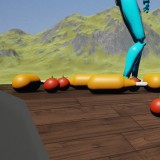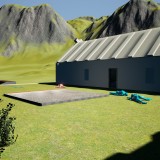Fallout 4, or, Why I Haven’t Been Working on My Game Recently
Just to get this over and done with, Fallout 4 isn’t “Skyrim with guns”.

It’s Oblivion with guns.
This isn’t bad thing, however; that’s more of a compliment than it may seem at first glance. Fallout 4, like Oblivion (and Skyrim) before it, isn’t just a game by Bethesda Softworks, it’s a Bethesda Game, something I’ve come to consider a genre unto itself. These Bethesda Games follow the same general pattern: you start off unarmed and unskilled, and immediately get to experience a major plot point. Following this, you’re presented with a sampler platter of each of the different types of weapons and attack the game has to offer, and are shown the other mechanics that game will utilize in the coming hours, like lockpicking and conversation. When this tutorial is done, you emerge blinking from the underground cave network you’ve been traversing for the past 15 or 20 minutes into a bright, sweeping panorama; a sea of trees that scratching up against the clouds that gently fade into the distant mountains, a number of strange, tall, alluring landmarks jutting into the horizon, beckoning you closer; and there you stand, with a comfortable weapon in your hand and wanderlust in your heart.
Every square inch of this opening panorama is designed to pull you in to the world and fill your mind with a checklist of places to visit and things to do, and in Fallout 4 it certainly does, because Bethesda has gotten very good at making Bethesda Games. These clichés exist because they work. There’s nothing inherently wrong with sticking to what you know, but it’s also not how you grow; a ship in harbor is safe, but that’s not what ships are for.
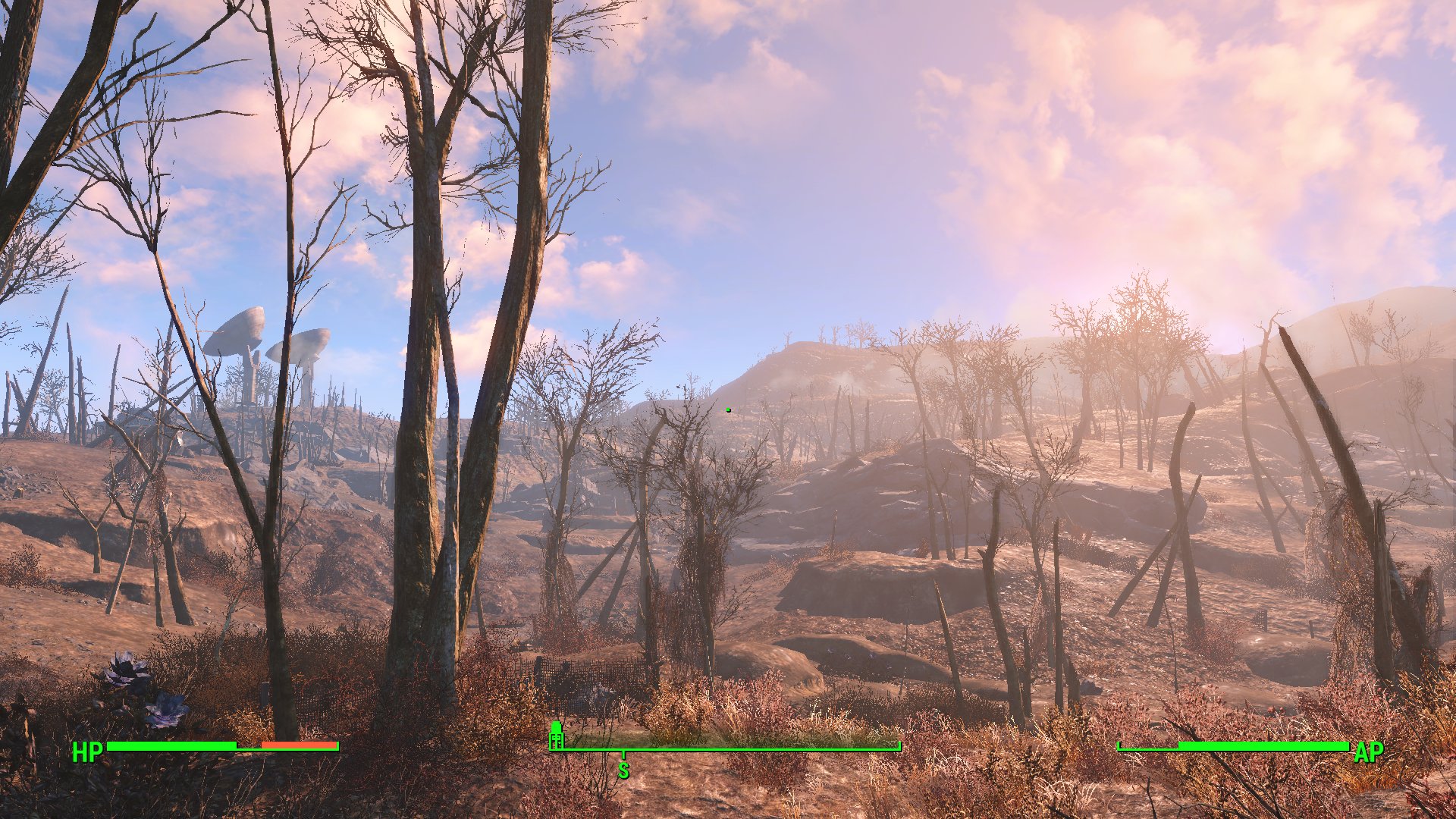
Just as the resplendent panorama mentioned above is actually a bombed-out wasteland filled with pockets of deadly radioactivity, so too does Fallout 4 have a number of blemishes, ranging all the way from areas with a simple lack of polish and misplaced props, to occasionally pants-on-head retarded AI, to comically broken pathfinding.
Aside from the NPCs occasionally getting stuck or running into walls – which is pretty well expected; this is a Bethesda Game, after all – the biggest and most obvious blemish was a game-wide lack of polish. Sure, Bethesda Games are glitchy, but I don’t remember seeing as many holes in the world in any previous games as I saw in Fallout 4. I never found one that was large enough to fall through, but several – since they show through to the bloom-filled void – were bright enough to be seen from clear across the Vault or whatever other structure they were in. The few I saw in the overworld blended in well enough to make me think that I noticed only a fraction of the ones that were there. These aren’t game-breaking mistakes, but they’re incredibly easy to see, even when you’re moving through an area at a full sprint. How did the QA team miss these? Were even checking for them? Were they found, but someone just forget to fill the holes in? It’s such an easy fix and so immersion-destroyingly obvious that I’m amazed that a single one made it into a release candidate, much less the final version of the game.
That being said, I do need to give Bethesda some credit: in my entire playthrough – 130 hours by Steam’s count, 106 by the game’s – I had only one crash-to-desktop. I never encountered any of the questline-glitching bugs or constant crashing that some players reported, and the only real issue I had with the game – agonizingly, borderline unplayably bad lag outside Diamond City – was patched to perfection within days of the game’s release. It has all the classic Bethesda glitches, yes, but it’s stable and performs pretty well. My only real performance-related gripe is with how big of a bite lightshafts/godrays/crepuscular rays take out of the framerate. They look good, but not good enough to justify keeping on anything but the lowest setting for me.
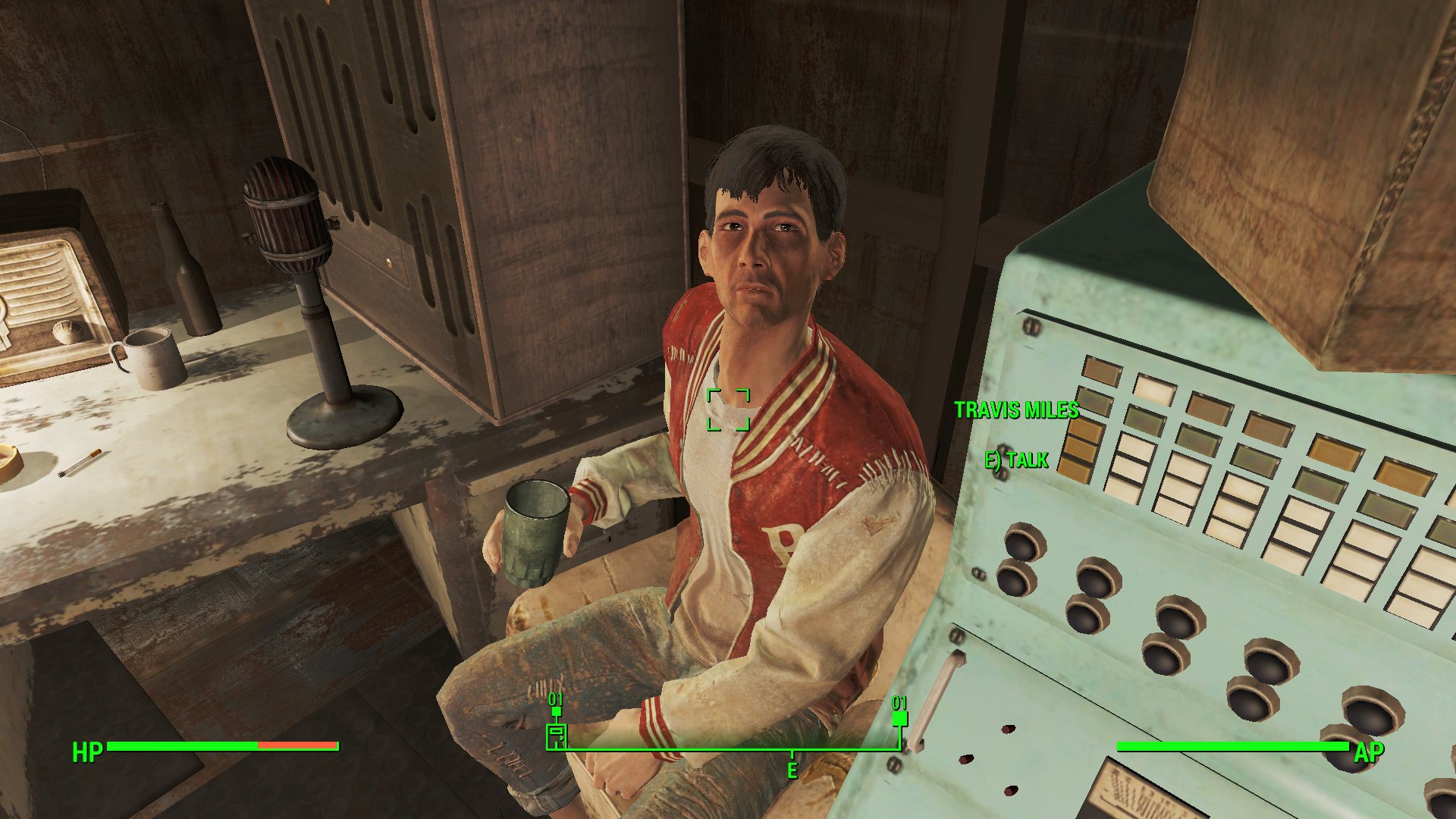
I’ve heard a lot of players getting upset at the perceived bastardization, “casualization”, or “xbox-ing” of the dialog system. It’s not perfect, but it isn’t shit, either, and I can see what Bethesda was trying to do, even if they didn’t quite get there.
Traditionally, video RPGs stemming from pen-and-paper games have had a multitude of long and verbose responses, whereas FO4 has very terse choices, often single words. When you’re playing a pen-and-paper RPG and the DM asks you how you want to handle a situation, you respond in character; the separation between you and your character is minimal at worst. Both you and the DM’s world that you’re interacting with have the benefit of human brains behind them, acting in real-time. If you make a choice that the DM didn’t anticipate, they have the ability to think of a “solution” on the spot, though how good that solution actually is depends on the DM in question.
Videogames don’t have this ability. Like it or not, until far more advanced AI hits the scene, videogames will always be on the opposite side of the visual fidelity vs. freedom of action spectrum from pen-and-paper games. Sure, developers can attempt to anticipate any number of actions that a player may take and include in-game logic and content for dealing with those actions, but doing so has a significant impact when it comes to plot. Since characters can’t think for themselves and their reactions are limited to what they programmers and artists have given them, each new dialog option has the potential to exponentially branch the plot, and the closer to the beginning of the game any given branch-point is placed, the more significant the impact on the amount of new content required. Having done some of this kind of development myself, I’m more inclined than I otherwise might be to sympathize with developers who get a little tense at the thought of having to write, voice, record, edit, compress, test, and check hundreds, thousands, or potentially millions of lines of dialog.
At the other extreme from the human-brain-powered dialog choices that sitting across a table from a DM will give you, is the tightly-focused sort of on-rails experience that spectacle shooters like Call of Duty or Battlefield provide; instead of telling the player when they’re straying too far from the given path, no option but the path is given at all, and the majority of the level design is linear corridors connecting multi-pathed (but still self-contained) fight arenas with cinematic sections. In a spectacle shooter, you’re just watching things happen to the character. In a pen-and-paper RPG, you’re actively shaping and controlling every aspect of the character. The middle ground (though still leaning towards the traditionally RPG side) is a game in which you’re not so much playing a character as you are guiding one; the main character isn’t really you. You do get a great deal of control over what he or she does, but the details of how they do it are sometimes not up to you.
If you’re used to playing RPGs that lean heavily towards the pen-and-paper side of the spectrum, any movement towards the on-rails side can be seen as a betrayal in some sense, and I think this is where a lot of long-time series fans’ frustration comes from. Yes, there’s a loss of detail and immersion that distances the player from the world, but there’s also a narrowing of focus that allows what’s left to be handled with more time, care, and effort, and what emerges is a game of generally higher quality.
That being said, though, there were a number of times when I would choose a single-word dialog option that I thought would be a calm or middle-ground response, only to have my character viciously lash out at whomever he was talking to, which immediately got a “what the fuck” response from me as I scrambled to figure out how badly I had damaged my standing with that NPC or their faction, or if I had fucked up a questline. There is some value in simplification, but oversimplification leads to a crapshoot, and Bethesda crapshoots wind up with a non-negligible amount of bullets going into your own foot.
I understand where the (admittedly valid) disappointment comes from, but since this is my first game in the franchise, I just don’t feel betrayed by the simplification. I’m sure that with FO4 as my introduction to the series, if I went back and played New Vegas, it would seem overwhelmingly complex at first. Similarly, there’s a good chance that I will feel that Fallout 5 is dumbed down in comparison to 4. Such is the nature of things.

Combat, on the other hand, is one area that critics and players alike seem to universally praise in comparison to FO3. Again, my Johnny-come-lately-ness means that I can’t comment on this comparison or how far the series has come, but I do play quite a few first-person shooters, and Fallout 4 actually holds up to the likes of Battlefield. It’s not quite as distilled and snappy, but gunplay is responsive and brutal, with death coming quickly on the higher difficulty settings (towards the beginning of the game, anyway, before you become overpowered) and kills feeling satisfying, especially with unexpected gibs. For a company whose games have a reputation of being one or two notches above Goat Simulator in terms of fluid animations and movement, this is a huge achievement, and really shouldn’t be understated. I give them a lot of shit, but Bethesda really has done a superb job in the combat department, and I can’t wait to see what they come up with in the future.
Somewhere during my playthrough – I don’t remember exactly where – I came across a special shotgun. Compared to their double-barrel brethren, combat shotguns are special enough already (increased ammo capacity and the opportunity to go fully automatic later down the line with a small reduction to damage output), but this shotgun had 15 points of added explosion damage. Given how far beefy enemies went flying backwards and how many lower-level enemies got launched into space, I have a funny feeling that the damage calculation may have been applying the additional 15 damage per-pellet instead of to the whole trigger-pull. This is probably the most hilariously overpowered weapon I have ever had in a game, but it actually did balance itself somewhat. Shotguns, with their pellet spread, generally appear in games as either exclusively close range weapons or close-to-medium range. This weapon, because of the fact that each pellet exploded upon impact, dealing 15 damage to anything within each explosion’s burst radius, became a medium-range only weapon; it would kill the user with a single shot if it was used in close-range. This is, by far, the strangest balancing of an overpowered weapon I have ever seen, and actually it worked for most of the game – by the last few hours, I was overpowered to hell and back in almost every respect, so the shotgun was just icing on the cake.
I’m not really a melee type of guy, so I can’t tell you too much about that part of the game, but the few melee weapons that I did try seemed stabby and bashy enough. Bayonets and pistol-whipping are included as well, though the long cooldown time between attacks makes them useful really only once, either as an interrupt or sprint-stopper, or to stun your opponent long enough for you to get behind some cover and reload or stimpack yourself.
I’m also not all that partial to heavy weapons, though even I found some fun with the Fat Man, a portable nuclear bomb launcher. I just don’t seem to enjoy the slow movement and slow firing that comes with heavy weapons; I prefer a fast and twitchy combat style. Luckily, FO4’s small arms certainly deliver in this respect; run-and-gun with semiautomatic rifles, machine pistols, and machineguns is fast and fun as hell, even if my shit aim ends up getting me killed pretty often. Add some Molotov cocktails and a half-destroyed urban center into the mix and you’ll start to feel like some sort of Polish resistance fighter, raining hell down from the rooftops. (Side note: there were a few moments during my playthrough where I thought to myself, “hey, this probably actually is something pretty close to what being an insurgent fighter must be like,” but that notion didn’t really sink in until the very end of the main plot, which I’ll get to later.)
There are some genuinely strange weapons that start showing up towards the end of the game, weapons like the Gauss rifle, plasma rifle, and gamma gun, which have a distinctly experimental feel to them, and a home-built, hastily cobbled together aesthetic in the case of the gamma gun. I’m sure they each have their own niche uses at which they excel, but I was too pleased with the plain-Jane bullet weapons to put too much use into anything but the Gauss rifle, which quickly became my long-range weapon of choice.
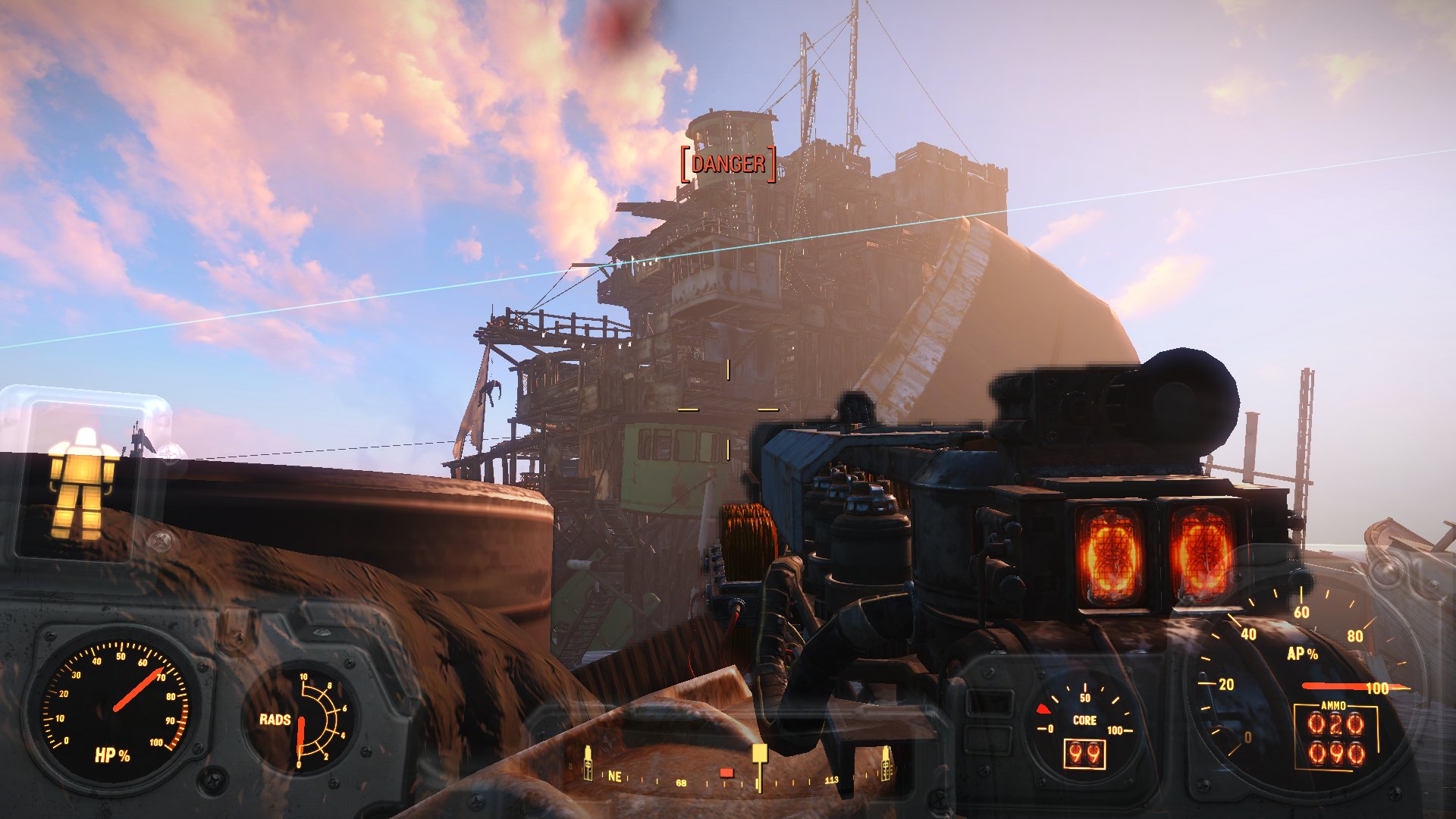
The combat itself is really fun, even when you get your shit pushed in by high level enemies. Getting defeated is generally more because you fucked up than because the enemies themselves are arbitrarily overpowered. This isn’t to say that the game has no bullet sponge enemies, but rather that the difficulty of combat never seemed unmanageable, which actually became a bit of a problem towards the end; combat wasn’t challenging when I was fully decked-out. The game made a point of lowering the amount of ammunition found in the world when I cranked up the difficulty level, but a few points dropped into various Luck perks brought the drop rate back up where it was earlier. I ended up intentionally hobbling a lot of my weapons with damage-reducing suppressors or lower-grade receivers, but even that measure soon wasn’t enough, and I was again able to plow through whatever the game threw my way.
My biggest gripe with combat is the companions, Dogmeat es-fuckng-pecially; damn near without exception, he interpreted thrown grenades as me trying to play fetch, ran straight into the thick of battle only to get completely wrecked within seconds, and then he just sat there, in the middle of the battlefield, whimpering and staring at me with those big puppy-dog eyes. Yeah, it sounds funny or cute, but after the fourth or hundredth time it happened, it got really fucking annoying. To make matters worse, if he wasn’t running headlong into death’s open maw and racking up a massive stimpack debt, he was standing either directly in front of me, soaking up my precious outgoing ammunition like a canine James Brady, or wedging himself inbetween me and the doorway I needed to escape through and panting his big, dumb head off as a supermutant applied a fresh coat of my brains to the walls and ceiling.
That fucking dog got me killed more times than he saved me. As much as I wanted to keep him around as a companion, I eventually learned to use him as either a meatshield or a simple distraction, and would order him into a herd of enemies with the hope that I could spray rounds into them before he was injured to the point of uselessness and the circle of baddies standing around him broke aggro and came after me.
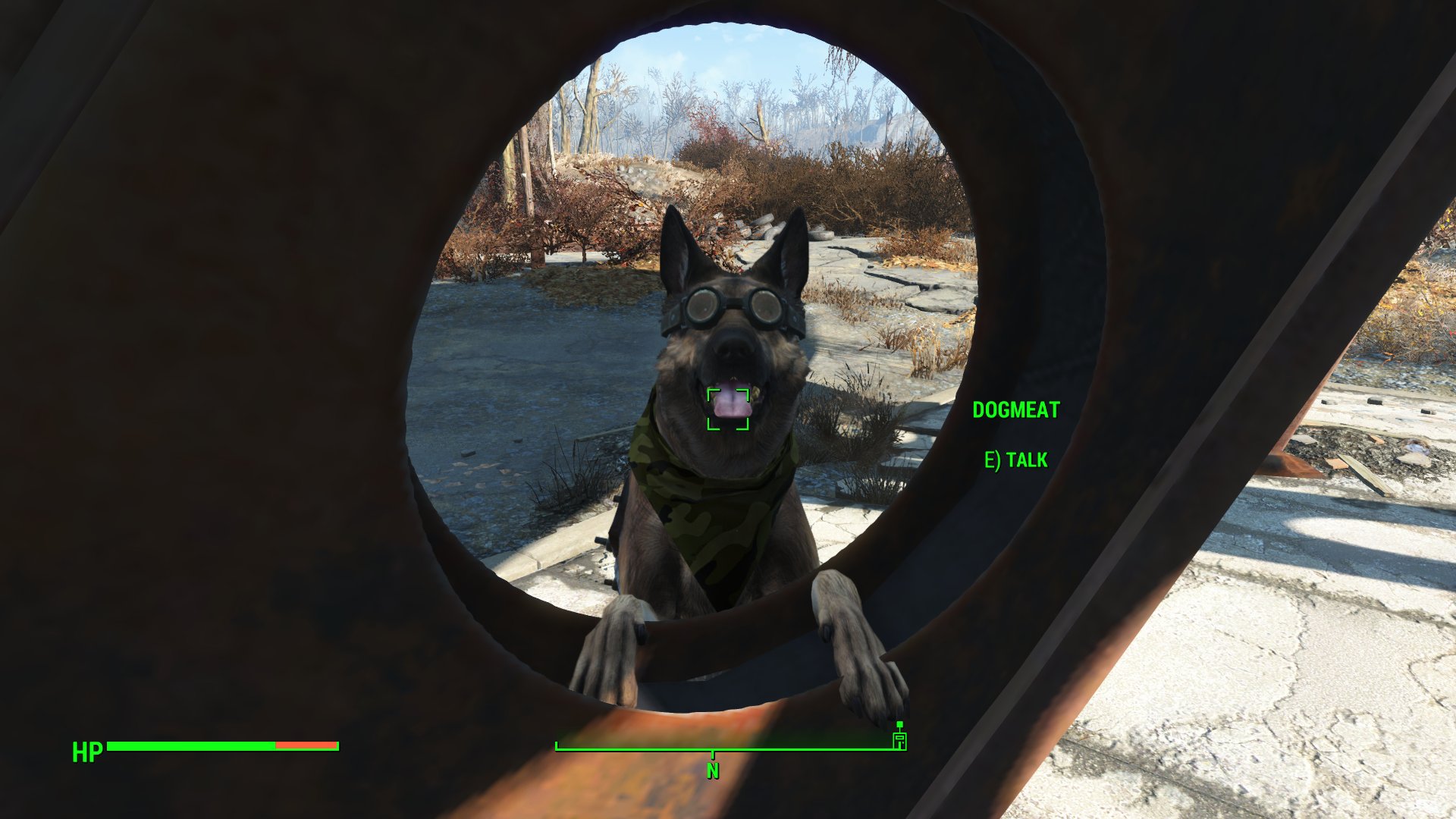
A tanky packmule that only either [growls angrily] or [barks playfully] gets old no matter what you do, so I eventually left him at a gas station by the starting area and set out on a journey with Piper Wright (paperweight? That’s supposed to be some kind of pun, right?), a journalist from Diamond City who turned out to be the most likeable character in the game for me by a fucking long shot. It’s not that I don’t like the idea of reinvigorating an old militia group or stomping heathens, but Piper’s quips and snide comments add so much to the feel of the game that once you’ve traveled with her for an hour or two, it’s rather difficult to go without.
Some of the other characters I came across seemed affable enough, but all had their detractions: the Atom Cats, in particular, come to mind because their dialogue was cringey and forced to the point where it was a chore to even listen to, and I never got past the first few quests in their chain.
Cait seemed nice, but – sorry – I could not fucking stand her voice. I’m not quite sure what was wrong with it (I have nothing against the Irish, honestly), but it rubbed me so much in the wrong direction that I wasn’t even able to get through the first conversation with her. Plus, I don’t like the idea of enabling an addict, and there wasn’t even a hint that she might be trying to get clean. After finishing the game, I learned that it is actually possible to get Cait to sober up, but this apparently isn’t hinted at right away. I may give this a go on my next playthrough.
Strong was just plain dumb, the epitome of dumping all your points into Strength. His quest for the Milk of Human Kindness felt cheap and contrived, like it had been done a thousand times before and the writers made no effort to differentiate it from any of those other thousand times. Not long after meeting him, in a true display of genuine human kindness, I left him at a streetcorner somewhere along Mass Ave and never spoke to him again. Every so often as I passed through, I’d see him still standing there on the sidewalk, staring off into the distance.
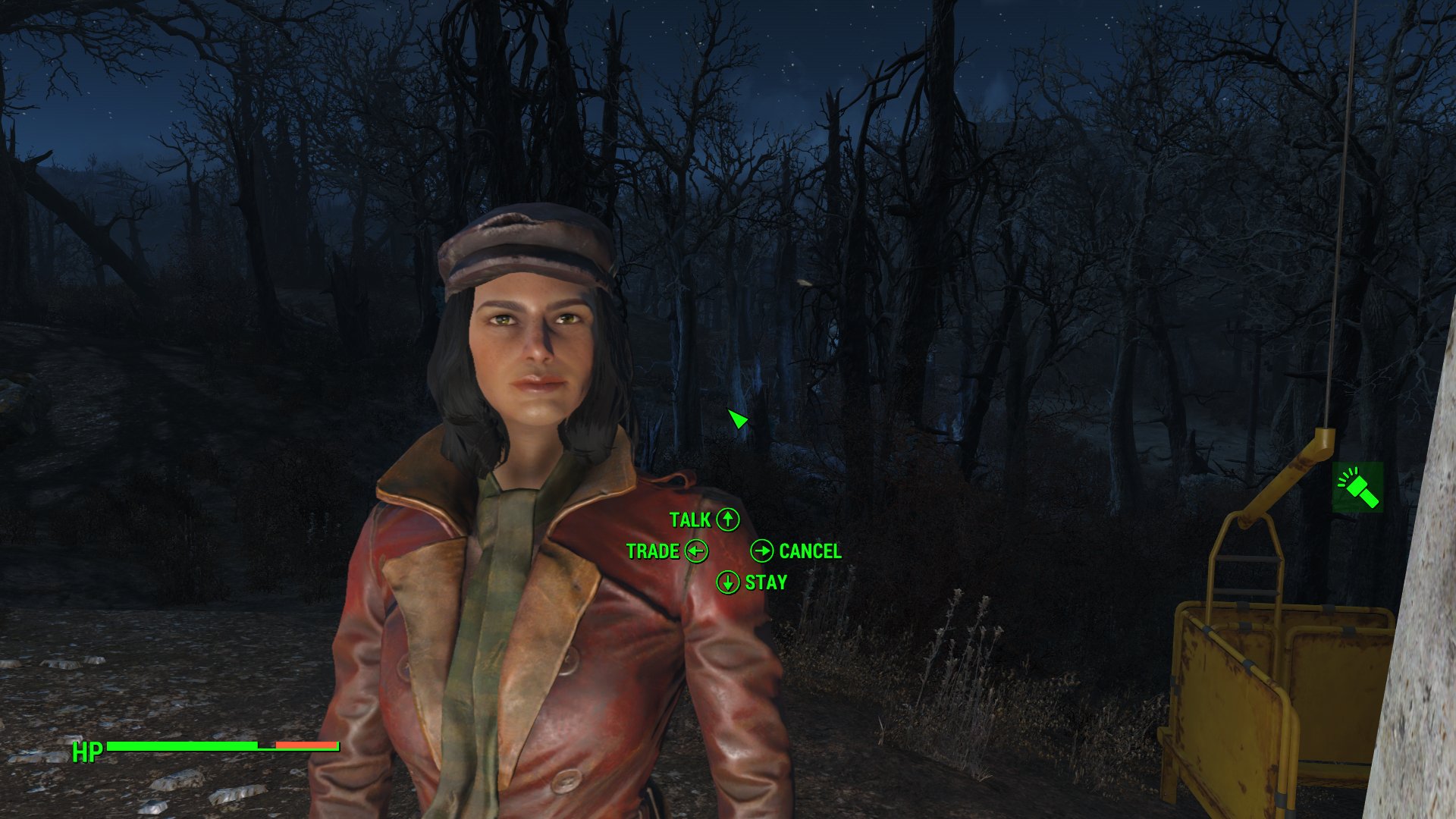
It seems like different companions were essentially the same, driven by exactly the same code under the hood, but given different “flavors”, essentially, to be paired up with the player’s playstyle, and with Piper’s constant stream of wit, wisecracks, and sarcasm, she snuggled right up against my playstyle and got comfy.
I liked Edward Deegan, a “getting to old for this shit” kind of ghoul, a whole lot. He worked alongside Jack Cabot – the quintessential mad scientist, acting out of such fervor for his work that he has discarded most of his morality and empathy – and his stoicism and dedication grew on me over time until I began to genuinely respect him. He didn’t appear to agree with his employer, but he was loyal, and something about the way Deegan spoke with Cabot made me think that things hadn’t always been this way, that Deegan might be still hanging around Cabot because he remembered what the mad doctor once was. The voiceacting was well done and his character was well written, but I was already going steady with Piper. When the time comes for a second 100+ hour playthrough, Deegan will certainly be my companion, and I plan on kicking the everloving shit out of Cabot.
Going back to Cait for a minute, she’s only the second junkie I came across. The first was Mama Murphy, an old woman hanging around the Minutemen who claimed to have the ability to see the future while high on Jet or other chems. Now, being a newcomer to the franchise, I thought this was total bullshit, but it turns out that psychics are apparently a real thing in the Fallout universe. I didn’t know this at the time, so I encouraged her to get clean, to give up the chems that were pretty obviously killing her (not to mention that I never really got any use out of The Sight, as she called her psychic abilities, so losing it didn’t mean anything to me).
With the right suit on my character and a few extra points dumped into charisma (I actually didn’t save scum this one), she saw things my way and agreed to give sobriety a shot. Unfortunately, that was the end of Mama Murphy. She didn’t die from withdrawal, there just wasn’t anything else in the game for her. Someone in my livestream’s chat mentioned that this was going to happen, but I had thought that she was now going to go occupy her time with something else, like writing or gardening, or some other activity, but instead, she basically ceased to be a character, as if the writers hadn’t envisioned someone taking this route and consequently did not give her a single line of sober dialog. Sure, she’ll acknowledge the player with a “hmm?” or something like that, but there are no more conversation options with her ever again. Once she goes sober, that’s it; she might as well be dead.
If this was planned, if this is a canonical result of losing The Sight, it would have been damn nice to know about beforehand. If this is something that came about as a consequence of budgetary or time constraints, couldn’t the developers have just blocked off the option to get her sober, maybe even adding it back in with some DLC somewhere down the line? I really don’t know if I should categorize Mama Murphy’s sobriety as a bug, an oversight, or a part of the gameworld that I didn’t understand.
The last mechanic I feel the need to touch on is the Power Armor. I’ve heard several of the long-time series fans remark that the Power Armor is available too early in the game, that it overpowers the player early on and makes things too easy. I didn’t find this to be the case; for all its additional armor rating, the loss of speed and maneuverability simply isn’t worth the reward. Yes, you can soak up more incoming damage, but halving your speed means that you’re going to be exposed for twice the amount of time, which practically negates the benefit.
Where the armor truly shines, however, is in the Wasteland; which, somehow, is one of the most beautiful sections of the game. This stark, barren, bled-dry land is peppered with hazards, most notably the pervasive radioactivity. Without a radiation suit – which are both exceedingly rare and completely devoid of armor – or some Power Armor, the incoming rads will quickly kill you if you don’t carry an entire pharmacy’s worth of Rad Away with you. It’s in a location like this that the Power Armor’s role becomes apparent; it’s a vehicle. It’s not a piece of equipment to be worn and judged like armor, it’s closer in use and form to a car. Where Skyrim had horses, Fallout 4 has Power Armor.
It’s a very slow car, however, and I really would have liked to have seen the same level of upgradability and customizability given to Power Armor that the weapons got, or perhaps even more. Granted, somewhere between the middle and end of the game, even the weapon customizability began to wear thin, but the Power Armor ran out of customizability options far sooner. Instead of just being able to add a single upgrade to each slot, I think the armor would have benefitted from varying subsystems on the chassis itself; power core overclocks or something in the other direction that would reduce output but heighten efficiency; smaller, more intricate machinery that could reduce weight at the cost of protection; higher-power servos and pneumatics that would increase movement speed and agility at the expense of power consumption – there are plenty of options. Instead of each piece of armor, these sorts of subsystem upgrades should be done to the chassis itself, which would have a balancing effect via forcing the player to focus on a single chassis rather than treating armors as something they can use once and toss away.
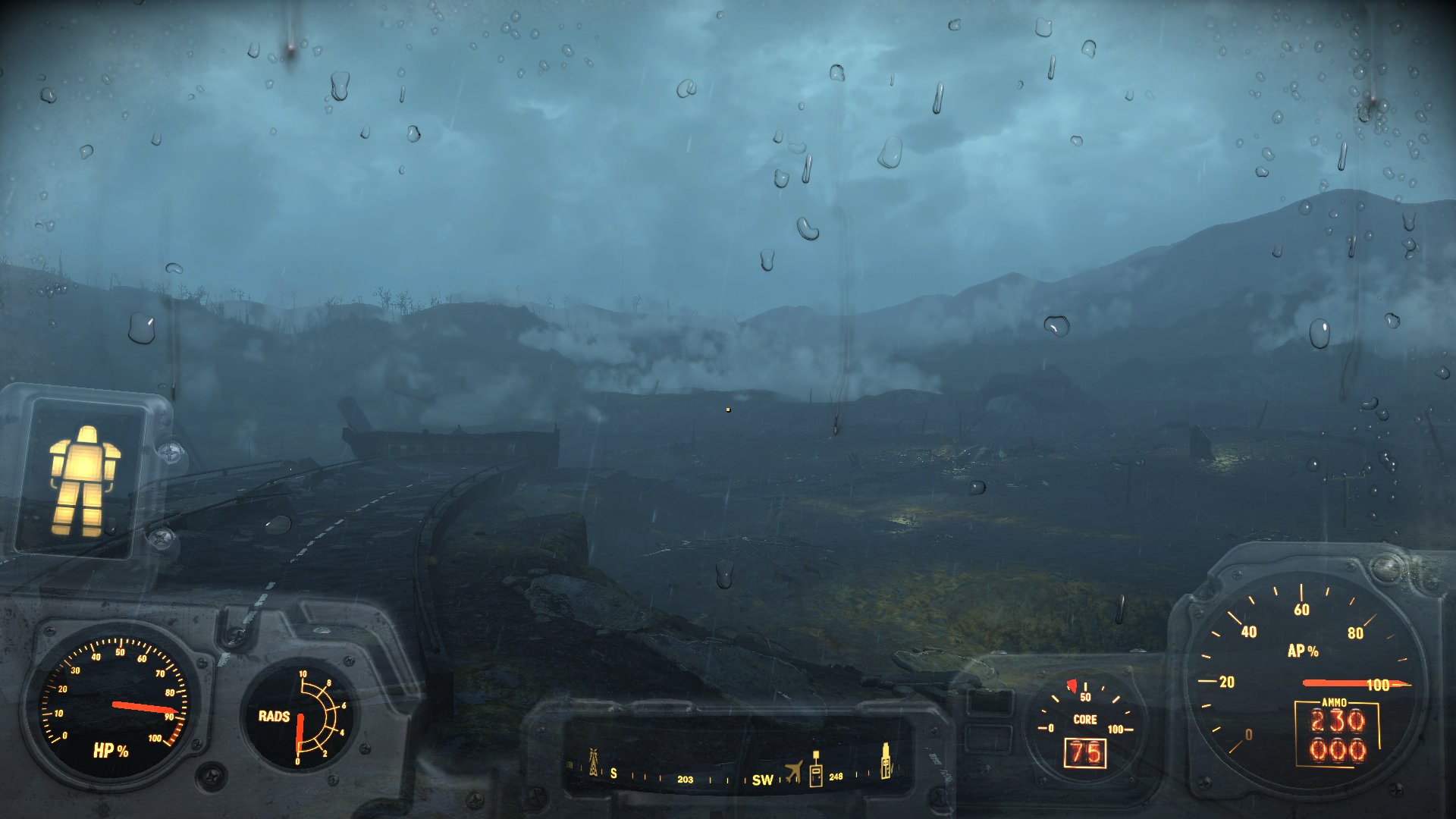
Visual branding elements and art direction aside (both of which were brilliant, by the way), the game feels more like a loosely associated collection of vignettes than a carefully interlocking collection of stories. This smörgåsbord of stories works well, however; Bethesda is very good at making Bethesda Games, after all. Everything is condensed down in to bite-sized, easily digestible pieces, giving the player the chance to explore the beautifully crafted world at his or her own pace. Instead of being bolted to the story and taken along for the ride, the player has the option of pacing the story for themselves. Want some action? Mark one of the radiant quests you undoubtedly have as the active quest and go shoot some shit. Want a mystery to untangle? Walk in a straight line in any direction and you’ll eventually come across a story told either purely environmentally, with props, lighting, and level design; via dialog, through radio transmissions or Holotapes; through text, in the form of letters, graffiti, or newspapers; or any combination or permutation of the above.
This style makes perfect sense; the main plot is about a nomad. Even at the thematic level, this is very much a game about wandering. This isn’t the main character’s home; your home was 200 years ago. You’ve been ripped out of it and dropped in a world where you don’t have any intimate, well-defined connection to anything. Even the few places where you did have history have long since changed and faded away. Shaun, your closest tie to the world, has changed by the time you meet him, almost to the point of unrecognizability. You don’t belong here, yet here you are.
The mechanics of the world dovetail nicely into this idea, too; most of the game, by volume, involves scrap and items. Whether you’re taking someone else’s prized possessions and breaking them down into their constituent components, looting valuables off a corpse, or just simply destroying things, everything in the game is temporary and fleeting. Even when you do settle down, it’s never permanant; you’re on the road far more often than you are at home, farming. This, I think, was the uneasy undercurrent I felt the whole time I was in the Institute, the bad feeling in the back of my mind; I don’t want to stay at the Institute, I don’t want to be a researcher or whatever. I want to be up there, no matter how dirty or dangerous or fleeting it is. I want to be exploring, I want to sleep under the stars.
Even though settlements may come under attack and Preston Garvey may tell you that, “we’re making a real difference out here,” there are no active territorial struggles outside of a few main quest events. Even if you fail to respond to a settlement under attack, all you’ll need to do is to rebuild a few of the turrets when you do eventually show up. The same goes for enemy encampments; no matter how many times you carpet-nuke that supermutant holdout, they’re going to respawn. NPCs may come and go, but you never see any territorial lines shifting. This is a good choice, at least mechanically; if you had to micromanage each settlement, the game would be insanely complicated, no fun, and would very quickly drive people away. The “set it and forget” it attitude is a necessary choice for gameplay, but it does remove the feeling that you’re building anything, no matter how often the NPCs may tell you that you are.
Creation is not the focus of the game, though. It’s not about the forging of new empires, not about creating new civilizations; it’s about one guy, one nomad, trying to find his kid in a world that has, quite literally, passed him by. The difference between expectations and reality when you meet Shaun, though, further serves to drive home the idea that you’re a man out of time. The old world you knew is gone, just like the old Shaun you knew is gone. It’s a game about creation and destruction, about taking things apart and putting them back together, about losing the past while dismantling the present and not thinking of the future. I suppose that it’s possible to make an argument that you’re planting trees in whose shade you’ll never sit, but it never really felt like I was actually building anything.

There were a number of quests in the game that made me feel genuinely bad. The first and probably most obvious is a quest chain where, no shit, you dress up in a costume and kill whomever the voice in your head tells you to kill. The costume is that of The Shadow the Silver Shroud, a vigilante sort of superhero that Kent Connolly – a resident of Goodneighbor, the Ghoul town – once listened to on the radio. Since Kent is either unable or unwilling to take up arms and run into the night on a murderous rampage, he enlists the player to do his killing for him. I fucking love the idea of this quest, likely because I was raised on old-timey radio plays, but it was woefully under-contextualized; Kent, acting as the narrator in his little play, just barks orders over the in-game radio, informing you that such-and-so is cooking up drugs and that they are overdue for a big helping of “justice”, which, obviously, translates into a couple magazines full of lead for them and their henchmen. Never mind that these are the same drugs the player character is cooking up and selling, never mind that we have absolutely nothing more to go on than Kent’s word, never mind that – on more than one occasion – my prey didn’t fight back and actually tried to run and hide; just go ahead and kill them. Staring down the barrel of a shotgun at a sobbing woman begging for her life while she deserves justice rings in your head is not a good feeling at all.
I realize that this is a really strange critique to bring up in a game that completely structures itself around unrepentant killing (so much so that attempting to play it without participating in the killing can actually break the game), but, in the overwhelming majority of all other instances, I can justify my killing, even if it’s just to say that I was simply returning fire. Not in the silver shroud missions, unfortunately; they feel like straight-up slaughter.
The questline culminates in Kent being taken hostage and the player freeing him (through about 20 minutes of save-scumming, in my case), after which he acknowledges that he didn’t really understand what he was getting into, and it’s possible to convince him to stop his whole Silver Shroud experiment entirely. The protracted, murderous rampage I had been on for the past hour or two, however, had dulled my senses and broken my suspension of disbelief, so I just said “fuck it” and encouraged him to keep on pouring his time and energy into his superhero persona. Had I come across this quest earlier in the game I would have gotten some pretty sweet armor out of it, but instead, I got a reasonably fashionable coat and hat which I ended up carrying for a while, never using, and then just stuffing in a drawer. Sorry, Kent.
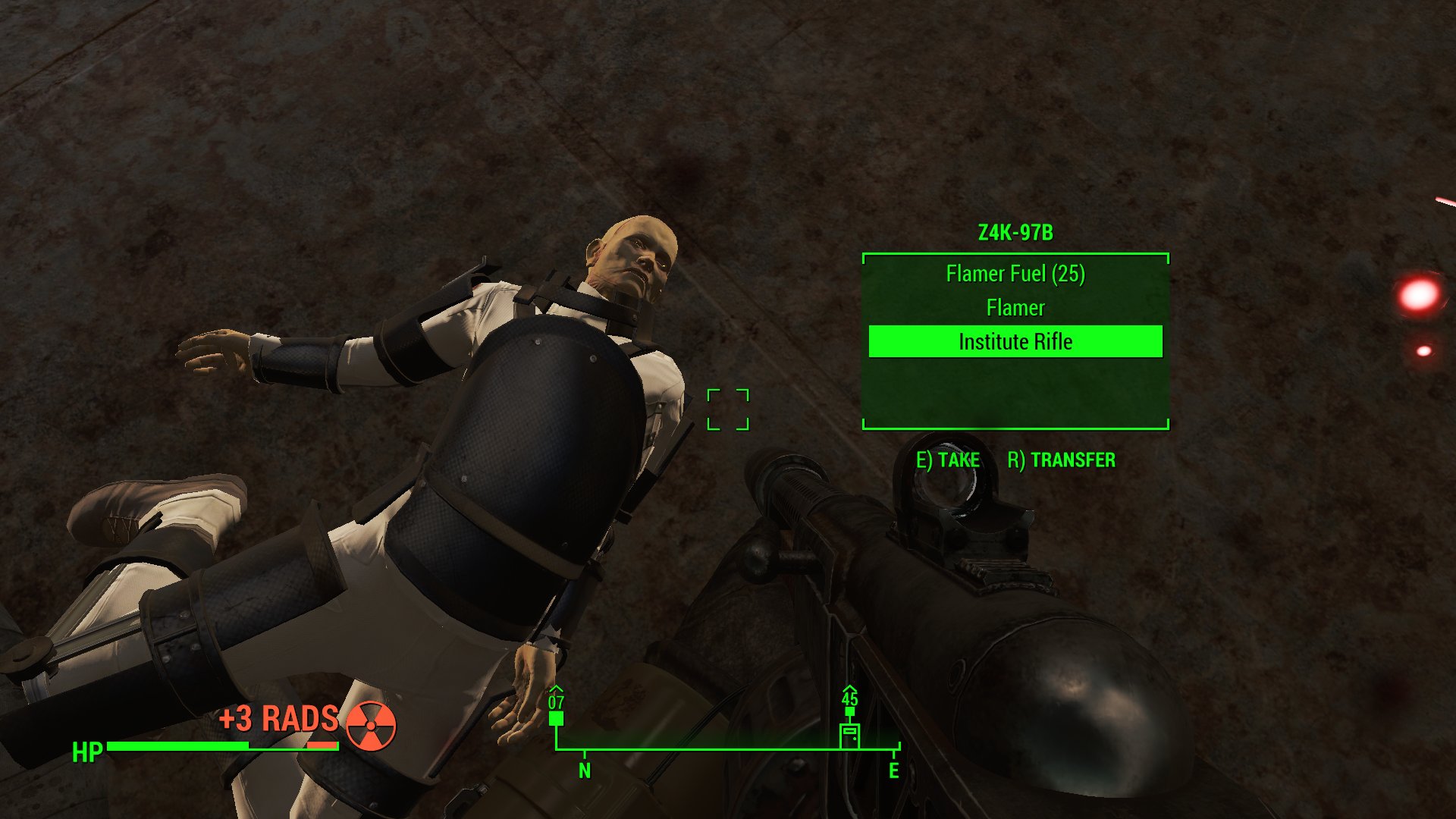
The second knot in my stomach was making the choice between the Railroad and Institute endings (the Brotherhood seemed like total pricks to me so I didn’t even bother with their questline past the first two or three introductory missions).
This was my first Fallout game, and I hadn’t read anything about the games plot before it was released, so I had no idea what to expect going into it, aside from all the visual branding elements that you can pick up from the box art and screenshots. The first time I came across a roving band of synths, it caught me completely off guard, and sent a chill up my spine as I watched the game’s plot veer off in a vastly different direction than what I had anticipated.
Now, oddly enough, I’m no stranger to the AI rights movement. My experience with it started out as a piss-take somewhere in the late 2000s as a reductio ad absurdum response to the growing din coming from the Tumblr side of the internet, but the more I read about transhumanism and the current state of AGI research, the more I began to realize that this is a genuine issue that we, as a society, are going to have to deal with a hell of a lot sooner than most of us think. I’ve spent a slightly embarrassing amount of time thinking about what constitutes life and what amount of sentience is required to receive the same level of rights that a womb-born human has.
So, naturally, when I came across the Railroad and heard their recruitment pitch, I practically fucking wet myself, joined immediately, and started trying to draw as many parallels as I could between the game’s central plot and other AI rights-related stories, like Deus Ex and Blade Runner. For a large portion of the game, in fact, I was convinced that the main character was a synth themselves and didn’t yet know it, and I still have some lingering doubts as to whether or not this is actually the case: for instance, why don’t any other characters in the game ever acknowledge the existence of the mannequins? More than just not talking about them, NPCs will actively path straight into them and do not react at all when hitting one. Are they really there? Can anyone other than the player character see them? If they are real, ehere did they all come from, and who’s been propping them up in the middle of the streets and on deserted rooftops?
As for the Railroad itself, the members of this motley crew were certainly varied and well-characterized; the chain-smoking, don’t need no man badass synth version of Harriet Tubman; the manic, chain-smoking inventor who had me running around Boston setting up hidden cameras, looking for fucking chemtrails or some shit; and the stern, chain-smoking female leader who didn’t have time to talk anything other than business. Come to think of it, I just now noticed that almost everyone in the Railroad smokes like a… steam engine. Was that intentional? How did I miss that for the entire game? The only one huddled in the basement beneath Old North Church who wasn’t constantly pumping emphysema into his or her lungs as fast as possible was the home-built robot, a six foot tall, shiny metal thing named P.A.M. with awkwardly large breasts (seriously, someone justify that), claws for hands, over-under eyes, and fucking agonizingly slow dialog that felt like it was penned by a sloth with a thesaurus.
They said jump, I asked how high (and if they had any duct tape). Things were going well in the beginning, but began to peter off the further we got from the sneaking around in the dead of night, smuggling robots between safehouses that I had enjoyed so much. Missions began to get more and more routine, and I found myself chasing after the trail of some elusive Mr. Tims, who apparently spent his time squirreling away audiotapes all over the Commonwealth. Given that for something like 20 to 40 hours of gameplay, I had no other interaction with the man, I began to wonder if he even existed, or if “Mr. Tims” was some kind of tongue-in-cheek reference to a series of never-ending radiant quests in another game that I had never played.
Occasionally, I was called on to investigate a safehouse that the Institute had discovered and raided, and while these missions were eerie, atmospheric, and well done, there just weren’t enough of them, or others like them. The newness had worn off and the tension had yet to begin building towards the end, and I found myself stuck in the radiant quest doldrums. Burnout is one thing, but the problems that came with the discovery of the Institute proper started to drive a moral wedge between myself and the Railroad.
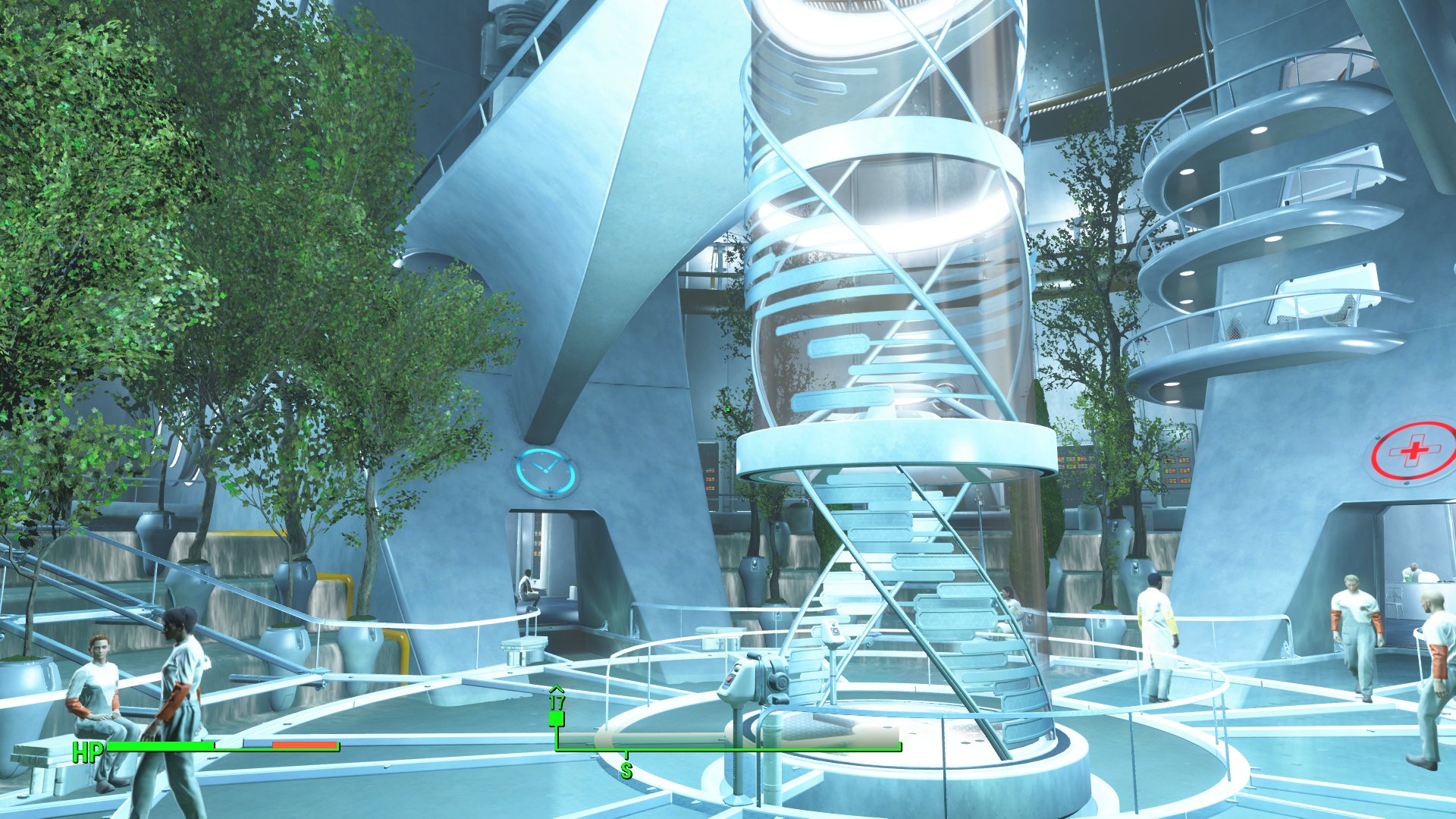
The whole Father thing felt like a bit of a cop-out, almost like the writers were as curious as to where the plot was going to go as I was. It felt like it was supposed to be some “oh, shit” moment, but didn’t get more than an “okay?” out of me, and I found myself asking “where do we go from here?” more out of a desire to see how creative the writers were than any actual investment in the plot. The answer, unfortunately, was nowhere; “Luke, I’m your son, join me and together we can rule the Commonwealth as Father and father” was about it. Aside from the drastic change of scenery, nothing below CIT was the wham line that I’m sure Bethesda had hoped it would be.
Come to think of it, is a Wham Loading Screen a thing? If so, the descent into the institute might have been one. I had pictured some kind of mechanical abomination pumping out a steady stream of killbots for the purpose of terrorizing the surface people, closer to the Strogg or Combine than to the saccharine, eggshell-white gopherhole it turned out to be. Teleporting into the Institute was certainly a shock, and the elevator ride down the tube into the large central atrium was even cooler; it certainly is one of the most memorable moments of the game for me, but because of its visuals, not because of its place in the story.
Since I was expecting to be trapped in the Institute – I mean, I was a spy sent in there with the express goal of destroying it – I spent much of my first tour of the place sneakily taking one (or two) of each shiny, rare, or undamaged item I could find. It wasn’t Fallout’s run-of-the-mill kleptomania that drove me; rather, I felt like I had some sort of anthropological duty to preserve at least portions of the culture I was about to destroy, even if for no other reason than to display these artifacts around my in-game house as a “been there, done that” sort of trophy. Eventually, my character’s strength ran out, and I was forced – with a hint of genuine sadness – to abandon some of my trophies to make way for new ones; scarcity had created an actual emotional bond between me and the location.
The bond was short-lived, though, as I soon learned that the Institute was willing to let me – a known agent of the organization that existed solely to destroy them – come and go as I pleased, and it turned into just another quest hub, and what were once priceless artifacts from a soon-to-be-gone culture were now just another source of plastic, springs, and adhesive. Father informed me that I would be his successor, for the plot was moving on and this meant that he had to die. Before he went, though, he was going to train me on how to run the place, and gave a combination of quests ranging from brief introductions to each of the Institute’s zones to topside assassination and mayhem missions. No matter how mundane or exciting the quests were, no matter how fun the combat or interesting the area was, everything about the Institute was dripping with bad vibes. Being able to work at (or at least around) the technological tip of the sword was pretty damn cool, but I still had their boogeyman image imprinted into my mind. Working with them felt like I was capitulating to the enemy, like I was succumbing to their guile.
When I was given the option to read off a radio announcement to the Commonwealth, I was surprised to actually have been given choices as to how I wanted to present the Institute to the above-ground world. I had expected to walk into a room, press a button, and complete a quest section, but instead it seemed like I might actually have some kind of say in how this organization would interact with the rest of the Commonwealth. This was a turning point, somewhere where I finally began to see a light at the end of the tunnel, as if I may actually have a chance to erase this boogeyman image.
By the time I had to make a final choice, I didn’t know which faction to choose. I was leaning towards the Railroad, but the last few quests on the Institute side of things had shaken my resolve pretty substantially.
I ended up siding with the Railroad, but I’m not sure how much that decision was influenced by some kind of genuine moral alignment and how much of it was purely a desire to kick off la Revolución and lay waste to that immaculate beacon of Bauhaus. A little bit of me felt like Father was a pompous prick and needed to be taken down a peg or two, but an armed revolution is more in the ballpark of a few thousand pegs. My other option would have been to run around the Commonwealth, terrorizing the population, with no clear goal or true endgame in sight, at least as far as I saw it.
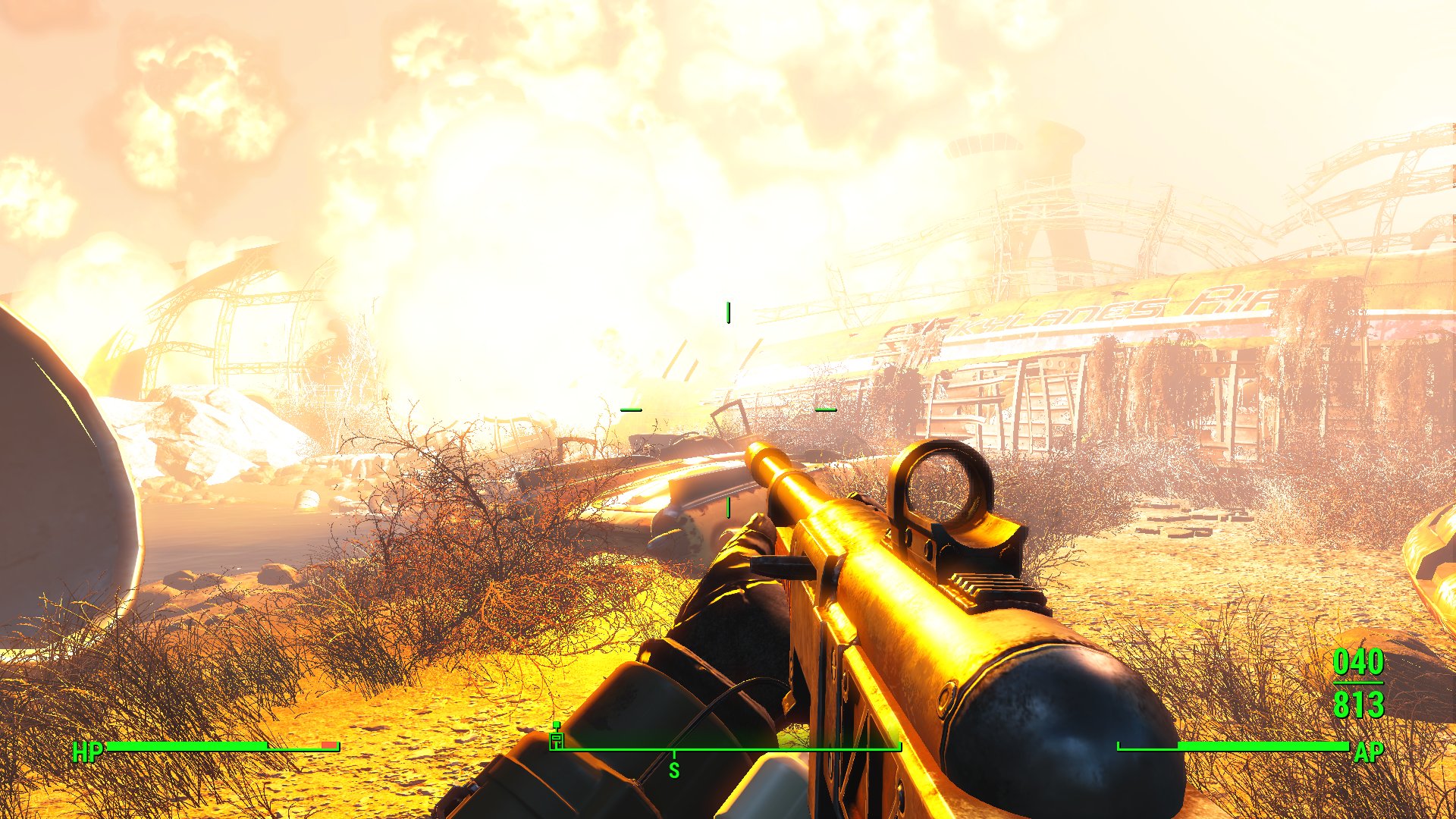
Just as a quick aside: remember that scene towards the end of Saving Private Ryan (spoiler warning, by the way; skip to the next screenshot if you haven’t seen it) where the German soldiers are firing across the bridge, and Tom Hanks comes up in the crosshairs? He gets popped, drops to his knees, slumps to the ground, and absolutely nothing happens. No music, no dramatic cut, none of the characters onscreen even react; the scene just keeps on going as if he were any other extra, and the impact on the viewer is far more significant than if there had been some long, drawn-out death scene.
During the Railroad raid on the Brotherhood of Steel outpost in the Cambridge police station, I had a moment like that. We’d fought our way to the roof of the station, and I was swinging my barrel from target to target, just concentrating on threats and cover and ammo, and for just a second, I caught the name Knight Rhys at the top of my screen as I pulled the trigger a few more times. This wasn’t someone I was close with, but I clearly remembered doing a few quests with her and even her complimenting me on my combat skills on an occasion or two. Nevertheless, she dropped, and I swung around to line up the next target. It took a few seconds to register that I’d just killed someone I’d fought alongside, and in watching my recorded livestream of that fight, it did make me pause for a while, but not long enough to get me killed (or even notice, if you didn’t know what to look for); I just swung to the next target and kept firing. It wasn’t an awesome in the hella sick, bruh sense, but I don’t think a game has ever made me stop and think about exactly who I was killing before, at least not in such a way that I perceived them as an individual with whom I’d had at least some sort of history. Even if it was only for a split second, I felt some regret, some actual remorse. I knew that by watching her crumple, I had closed off a large portion of the game for myself, that I had made quite a significant change to the world, but I couldn’t concentrate on that right now; I had to keep shooting. The show had to go on. That fight and Ryan are the only two times I ever remember having that feeling, and up until this point, I wouldn’t’ve thought that a videogame could make someone that kind of feeling.
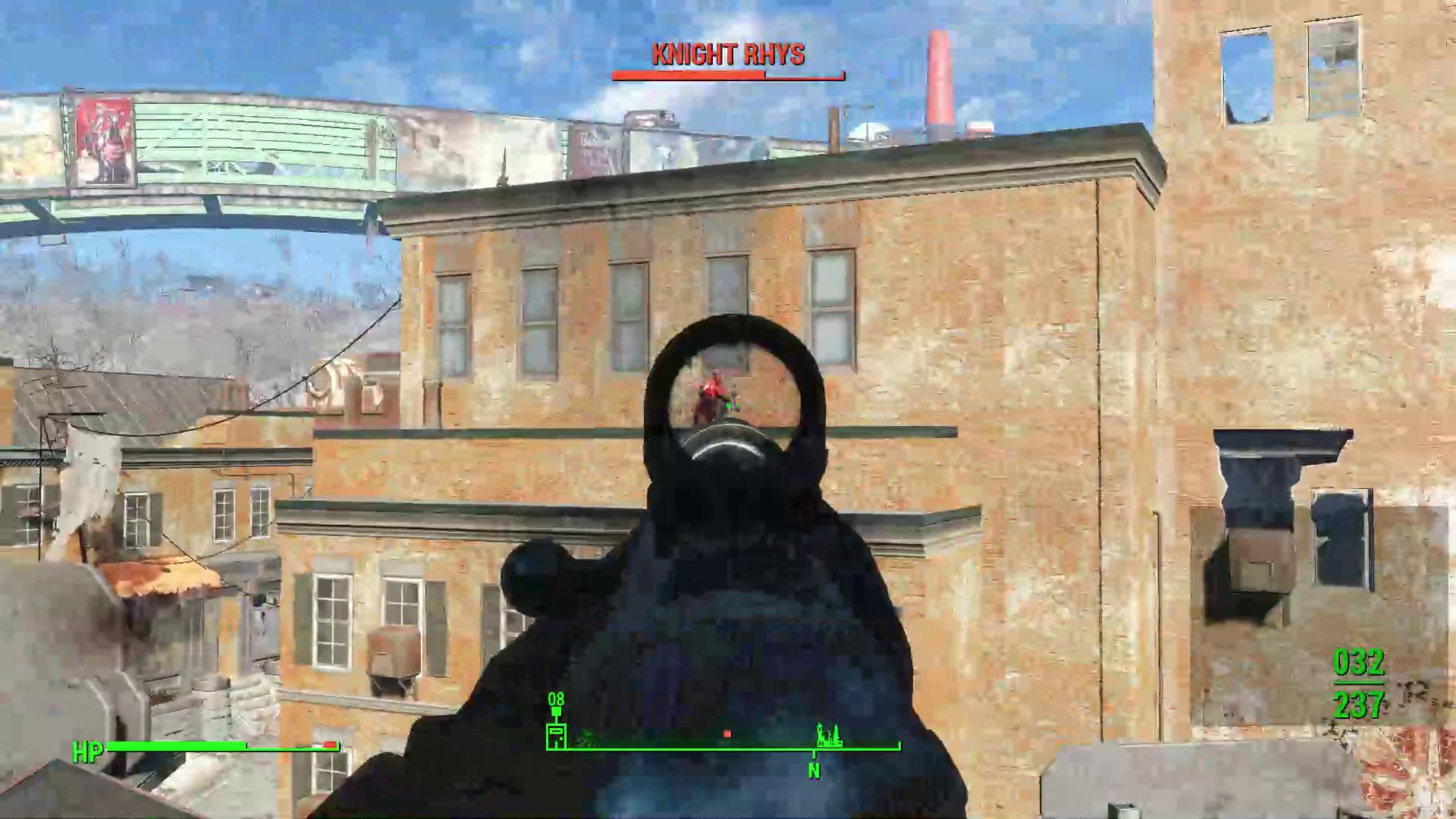
In stark contrast to that moment, we arrive at one of my biggest disappointments with Fallout 4: the end. I had been hoping that a middle-of-the-road type of agreement could be reached, that this was going to be something other than a binary decision, but that wasn’t the case. I spent a while during various downtime periods at work thinking about how I’d like to handle this situation, and came to the conclusion that the ideal solution would have been to take over the Institute and keep the synth production going, but to let the synths determine their own fate. The institute was clearly capable of producing large numbers of synths, and the railroad was capable of handling the social services end of the deal, so why not let both factions do what they’re best at? Why not work together to make the Commonwealth a better place for everyone involved?
Because fuck Player 1, apparently; this is a game, yo; there is no grey area up in this bitch, you either kill all of the red team or you kill all the blue team. I’ve heard that diplomacy is something the other fallout games excel at and I can completely understand how the longtime series fans would feel like the red-vs-blue approach to factions is a rip-off, because it is. I’m sure that in the eyes of the people who started off this series from a DOS prompt I’m nothing but a filthy fucking casual, the sort of Johnny-come-lately twentysomething with a bit disposable income and fond memories of my grandparent’s record collection that the Bethesda marketing board wanks themselves raw over – and, to be honest, that’s completely correct – but even I am put off by the everything or nothing approach to inter-faction relationships, even I think it’s bullshit. Granted, this isn’t quite as atrocious as DX:HR‘s “press button, receive ending” approach, but its close.
Wait, no; I did press a button to receive the ending. Fuck.
Either way, you can’t accuse Bethesda of shoddy writing. The forward momentum of the plot was so great that the last three hours of this game were completely un-put-downable; once the last few quests kicked into gear, there was absolutely no stopping them, and I played the entirety of the ending in a single sitting, staying up well past my bedtime. Was the writing unimaginative and occasionally lazy? Was it artificially restrictive throughout? Certainly, but genuinely shit writing would not get anyone invested enough in the plot to give a shit what happens to the Commonwealth after the bull emerges from the other side of the china shop, and holy shit did I ever find myself invested in that shop.
The more I sit here, trying to figure out how to phrase this, the more I’m starting to realize that the ending actually is my single biggest gripe with the game. The visual glitches are one thing, the pants-on-head retarded followers are another, but spending over 100 hours sucking the player in to a beautifully crafted world and then telling that same player to take the world out back and put a slug through its head is fucking bullshit. I feel cheated, manipulated. As I’m writing this right now, I’m feeling something close to how I felt at the end of the game, up atop that high skyscraper, watching the mushroom cloud slowly collapse back into the crater that was CIT just a few minutes ago.
You see, my last act as a potential member of the Institute was to help bring online a reactor that would provide ample power for the Institute’s occupants and experiments. Naturally, the Railroad can’t let this happen, and decide that not only will the new reactor provide the excuse to bring the Institute down, it will also provide the method. After a climactic fight in the reactor room where I had earlier in the same day been lauded as the future inheritor of the Institute, we sabotaged their reactor and scrambled back to the surface, remote detonator in hand.

As I stood up there and watched the waves of ejecta lap up and over the banks of the Charles, I realized what had been nagging at me for the past 20 or so hours; I’d let myself be swept up into a violent insurgency. This was the wham moment that should have happened when it was revealed that Shaun was the head of the Institute. I’d become a member of a terrorist group. This was the emotional peak that I’m sure the writers had envisioned, but it was all wrong; it had been turned inside out and corrupted. Yeah, I’d left a mark on the world, but it was a fucking crater. Here I am, flanked by a handful of NPCs congratulating me and telling me what a good job I’d done, and I just felt bad.
I hadn’t solved anything. I’d killed a shitload of civilians, obliterated decades, perhaps centuries of hard work and research, I had singlehandedly set humanity back, and all I had to show for it was a quest ticked off my to-do list. Yeah, Desdemona, the Institute were The Bad Guys, I know. Yeah, they mistreated synths and deprived them of rights that should be afforded of all sentients, I got that part; that’s how you got me on your side in the first place. What have we gained?
This wasn’t even close to what I wanted to happen. This was damn near the exact opposite of how I’d envisioned the ending, and I was the one who pushed the button. I’d become a fucking monster. I didn’t end up taking over the Institute itself, but I can’t help but feel that in a way, I did inherit Father’s role: I had become the boogeyman of the Commonwealth. I was now the Thing that moved in the night; the unseen force with the suppressed shotgun who crept up, leveled your house, and took your duct tape; the chaotic neutral who would nuke an entire fucking settlement full of noncombatants to get what he wanted and could snap at any moment. I was the epitome of everything that the wasteland was and the Good ‘ol Days were not; the living embodiment of everything uncivilized, everything brutish and violent and cold and uncaring.
If they had played this ending in a “not the hero Boston deserves” way, à la Dark Knight, it would have blown my fucking mind; I would have been ecstatic. Instead, I got something like 10 or 20 lines of dialogue, culminating in “come back when you want more radiant quests”. I don’t think I have never felt more used by an NPC than when that dialog tree ended. They could have done so fucking much with the power of that scene, but they did absolutely nothing. It was a massive letdown.
To be clear, if, at this point, the game had presented me with an option to rebel against the Railroad and assassinate their leadership, I would have taken it. In a fit of rage, I would have leveled Old North Church; I would have taken out Des, Deacon, Tom, and all the others. I don’t think I would have cared who offered me the option; I would have taken it. I felt betrayed.
This is probably a disingenuous comparison in many ways, but I think I understand at least a sliver of how ex-gangmembers or former terrorists feel when they make the decision to remove themselves from that life. I joined the Railroad because I wanted to fight for a certain vision of the future, a vision that the leadership fed to me in just small-enough portions to keep me coming back for more, to keep be on the hook as a tool. I’d given time, money and effort (both in-game and out), in the hopes of moving the world towards a brighter tomorrow. I put a lot of blood, sweat, tears, bandwidth, and coffee into forming the Commonwealth into something I was proud of, and I was left holding a smoldering shell of what I had started with. I was left feeling that, in many ways, the world was better off before I was in it. In the end, my ideals didn’t change, I just felt overwhelmingly like they had been used against me. We didn’t win because we believed in the right things or had the correct worldview in any sort of objective sense; we just won because we had more bullets.
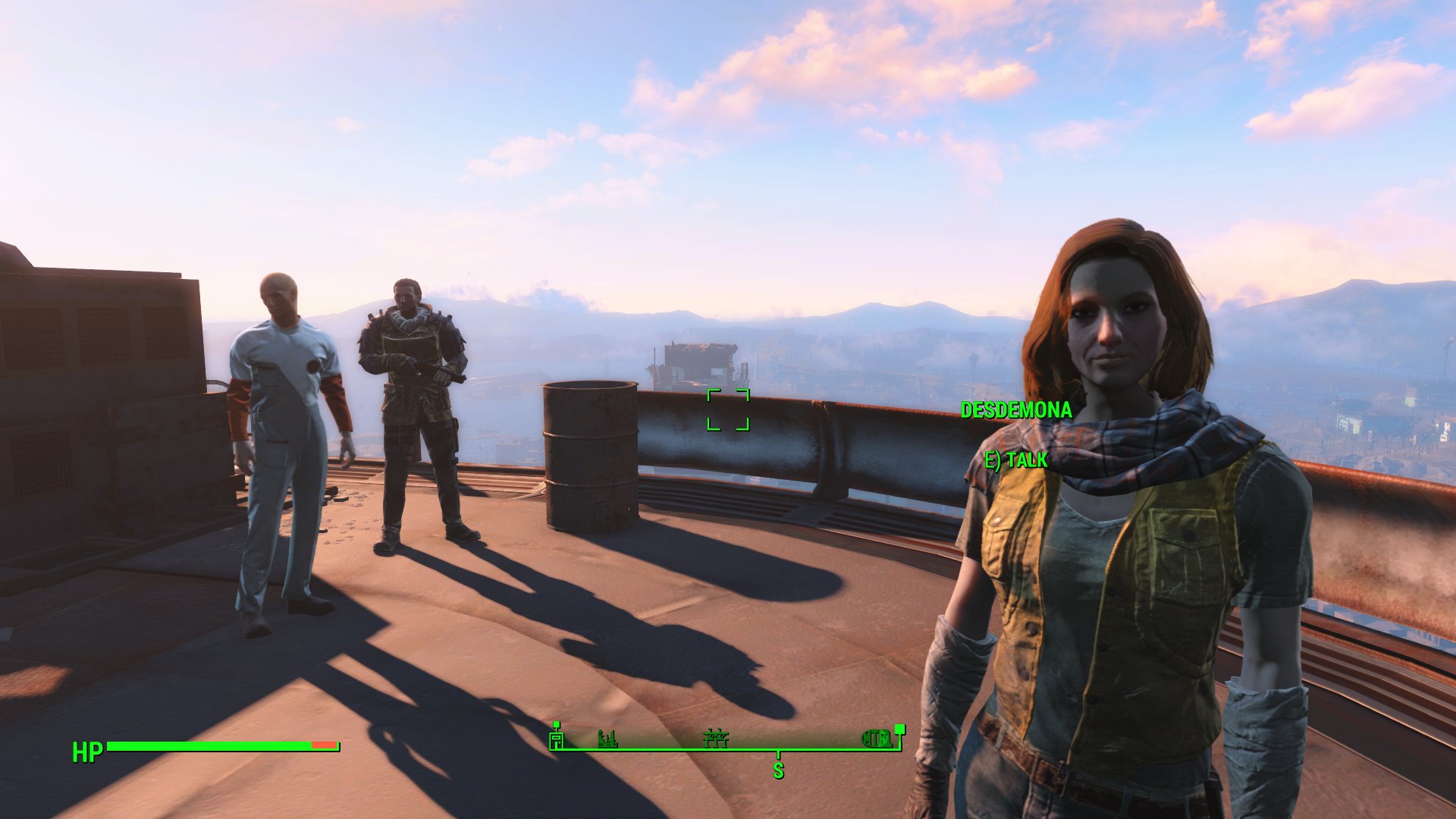
There’s a lesson in here somewhere. Maybe it’s something about unchecked enthusiasm, maybe it’s something about leaders who tell you what you want to hear, maybe it’s something about leaping guns-first into foreign lands, thinking you can painlessly alter the established order to fit your idea of Good and Right.
Is this the kind of feeling Bethesda wanted me to walk away with? If so, they fucking nailed it, but I doubt that it is.
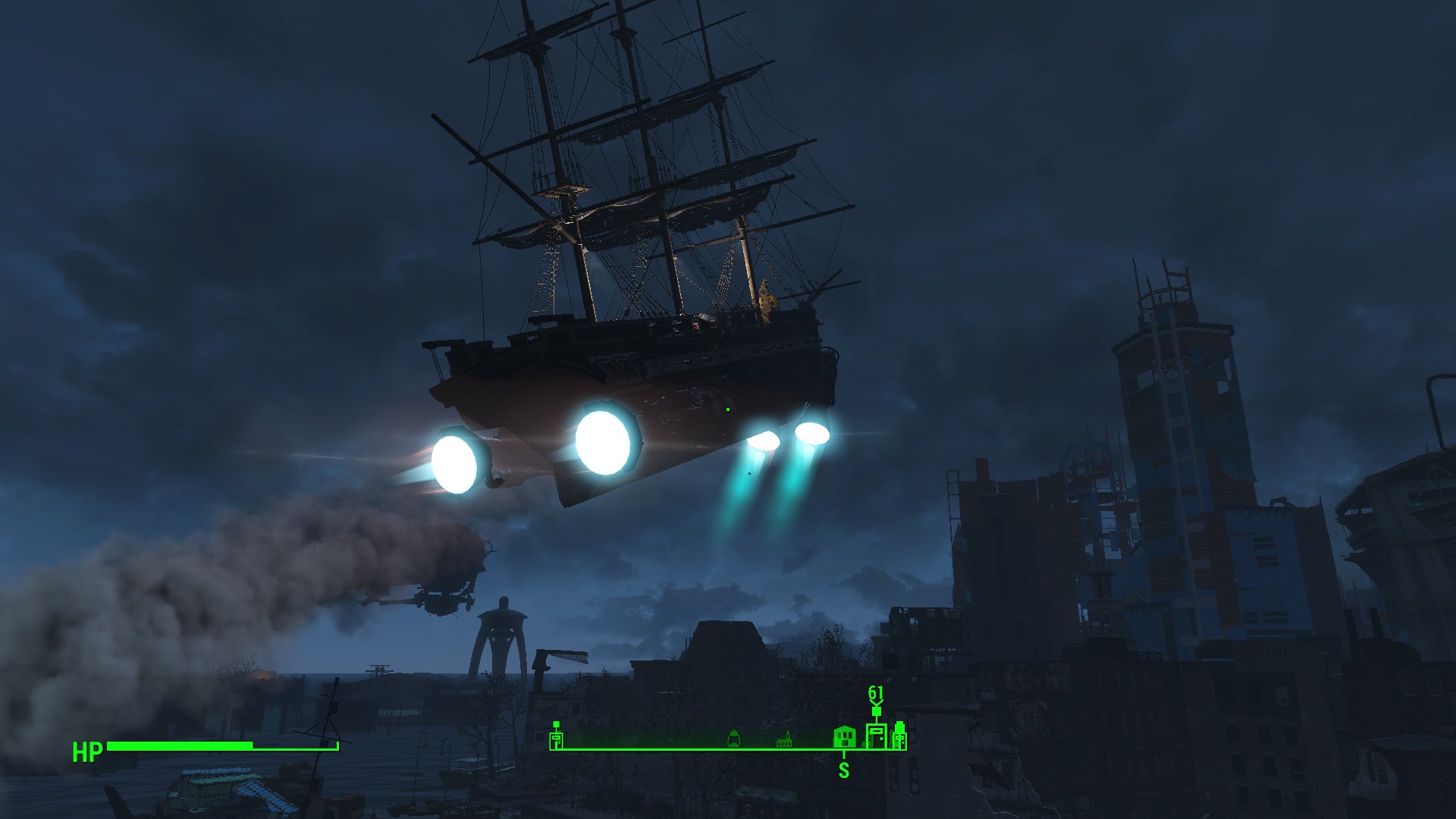
So, Fallout 4. It’s difficult to sum up in a sentence or two. It was fun, certainly, but I wouldn’t call it Game of the Year material. The ending was bullshit, but I enjoyed the hell out of all the other 129 hours I spent playing it. It has a whole lot of enjoyable systems, activities, and mechanics, but damn near everything this game does, other games do better. Was it worth the 60 USD I paid for it? At less than 50 cents for an hour of solid entertainment, you bet it was. Would I recommend it? Certainly. Am I looking forward to the next game in the series? You’re goddamn right I am; I can’t wait to see where Bethesda goes from here.


